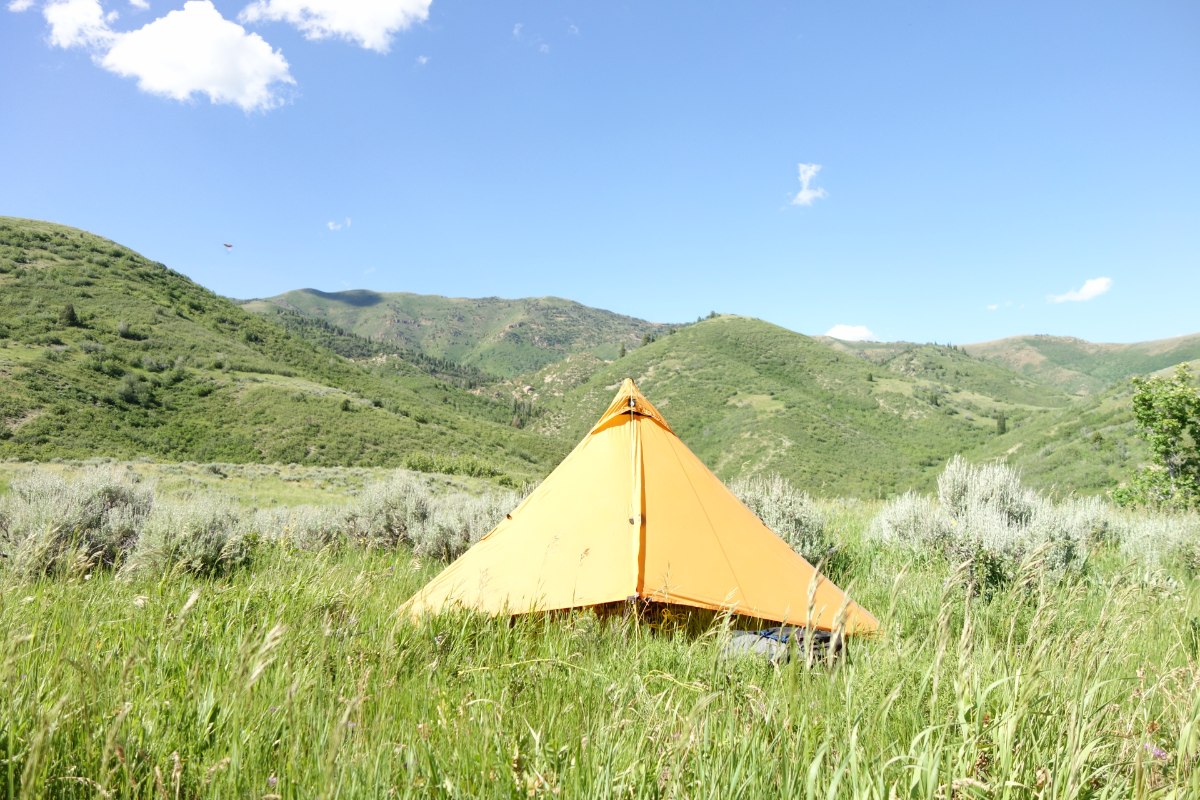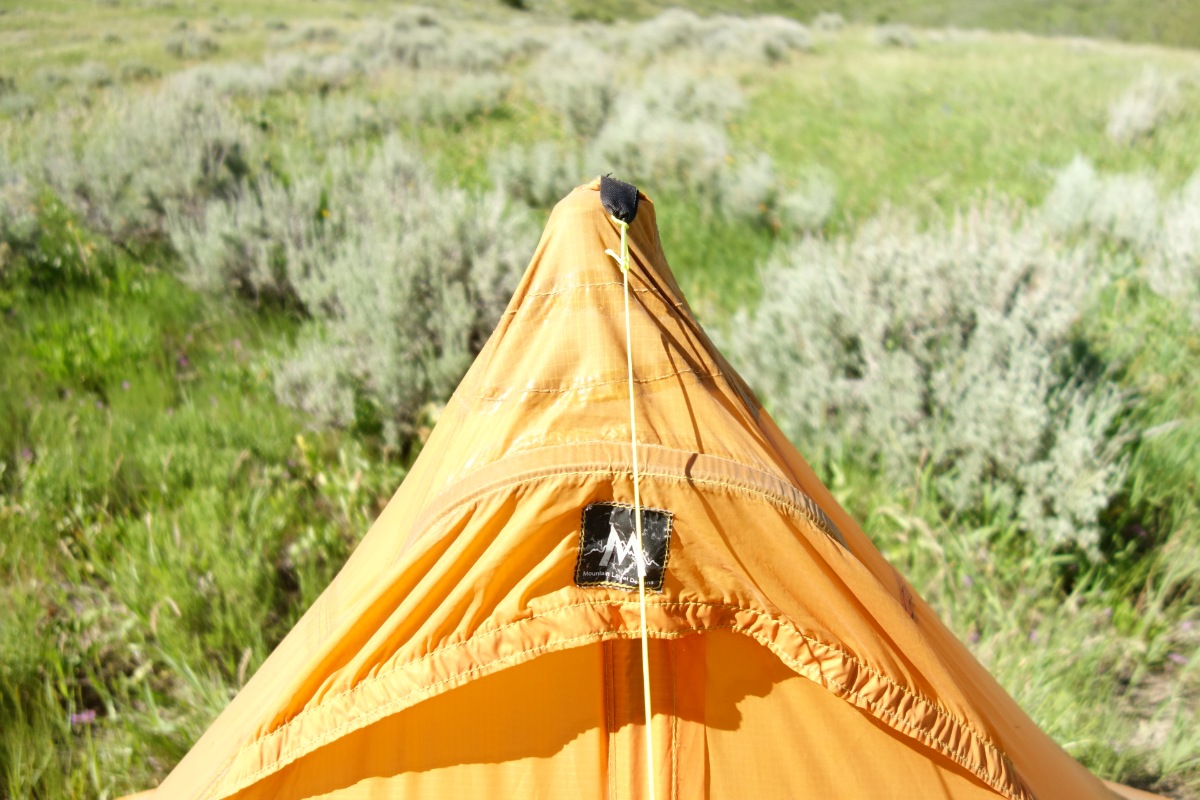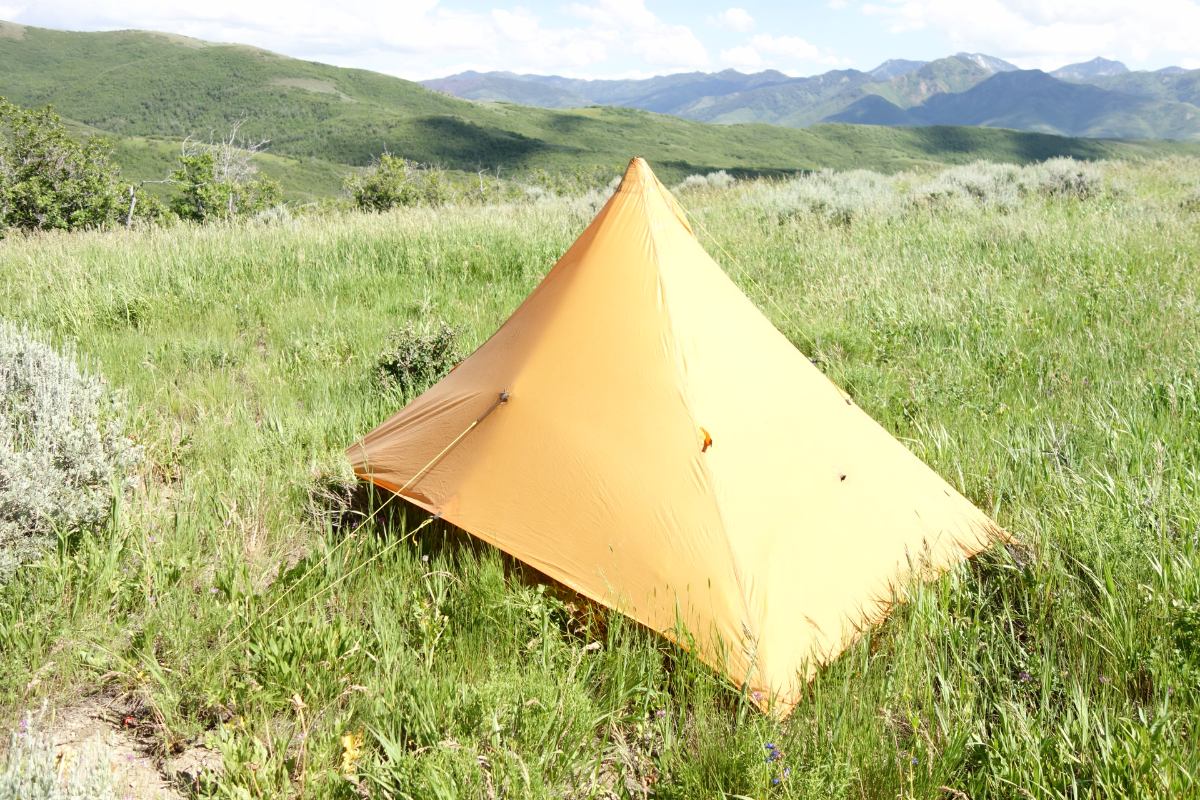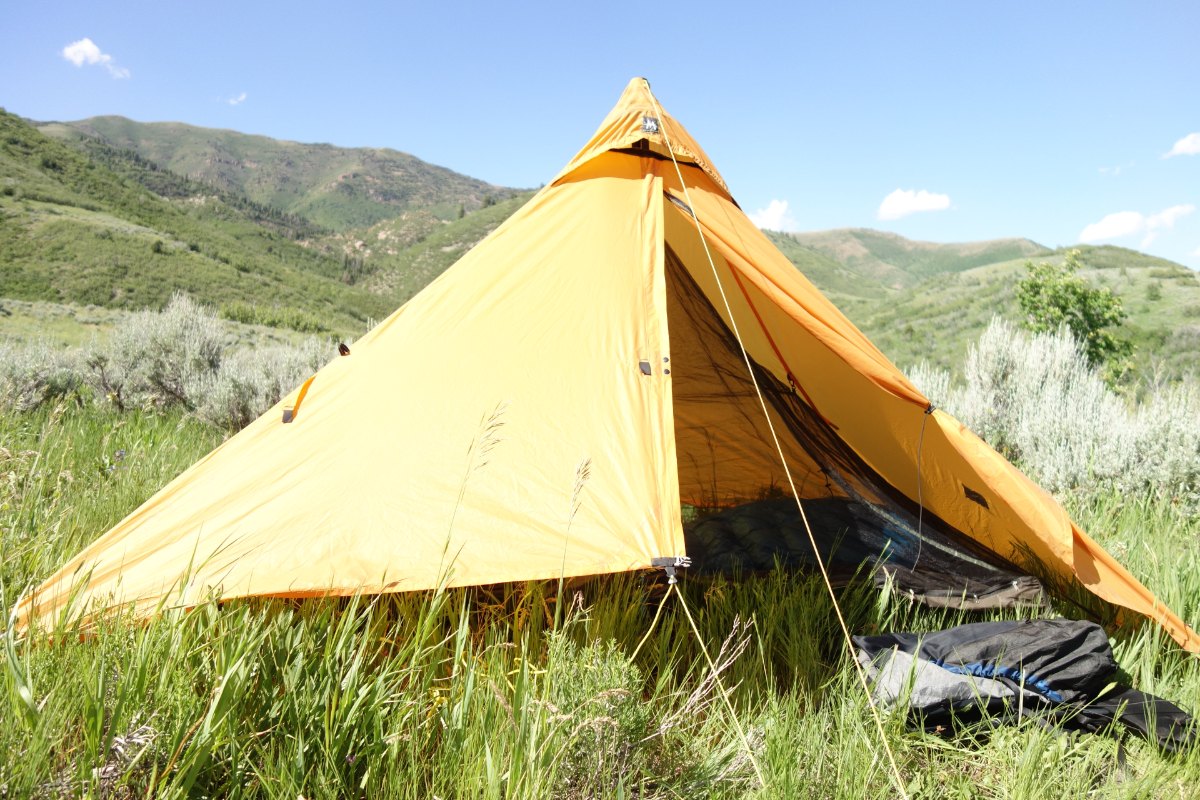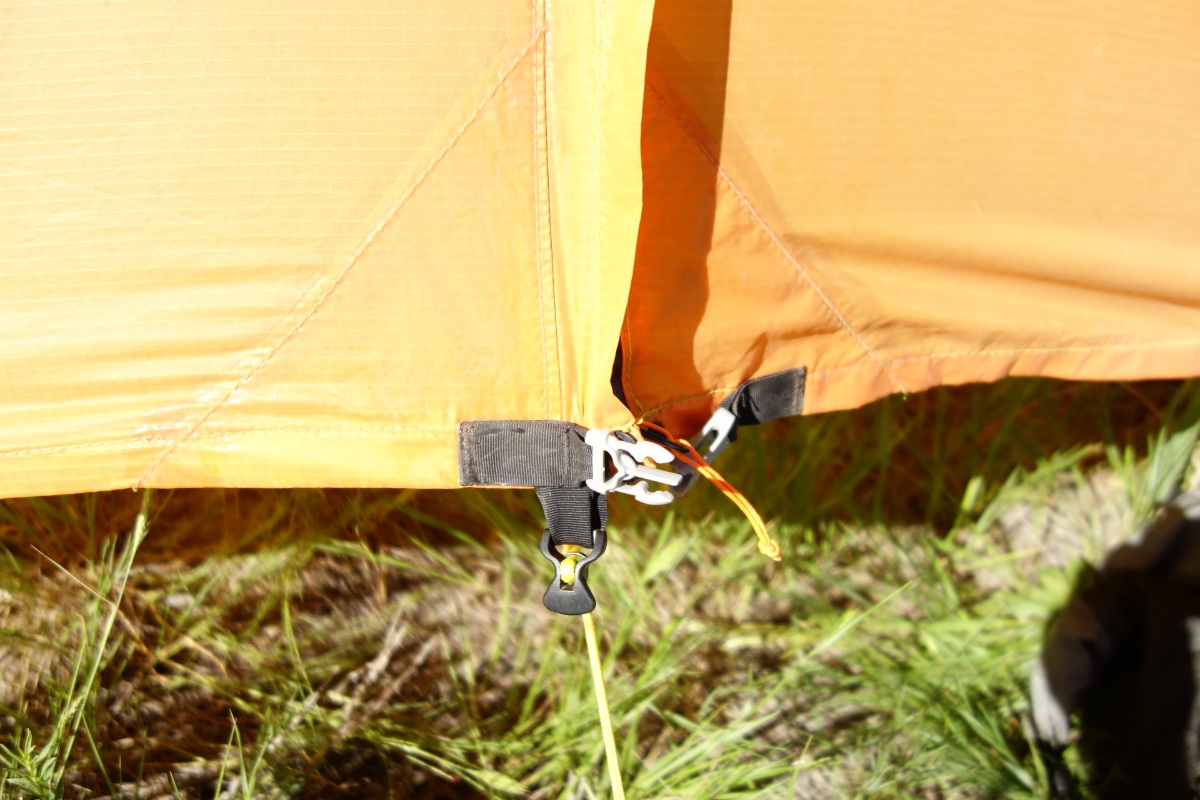The Mountain Laurel Designs SoloMid XL ($275-$455) is the shelter we choose when our fastpacking trips call for reliability. It’s a light, durable, stormworthy, and modular pyramid-style fastpacking shelter that accommodates both solo and partnered fastpacking trips. The tarp alone is 18.2 ounces, and including the SoloMid XL InnerNet, the shelter weighs 30.1 ounces.
When we set out to research and test fastpacking shelters, we decided to focus primarily on single-occupant shelters that could work for two in a pinch. We tested both tarps and double-wall tents, weighing the pros and cons of each.
Notably, the SoloMid XL stood out in a variety of ways. When using just the pyramid fly, this shelter is a simple and light tarp, and when using it in conjunction with the SoloMid XL InnerNet, it’s a double-wall tent. In tarp mode, it can sleep either one or two, and as a tent, it is a castle for one.
This modularity is one of our favorite things about this shelter. But it doesn’t just do a lot of things marginally well; it actually excels in each metric. The Mountain Laurel Designs SoloMid XL functions admirably in every pitching configuration, weathering gusting winds, shedding snow, and generally keeping us warm and dry on any fastpacking trip.
We have enjoyed this shelter so much that we named it one of the best ultralight tents in our best ultralight tents guide.
Shop the Mountain Laurel Designs SoloMid XL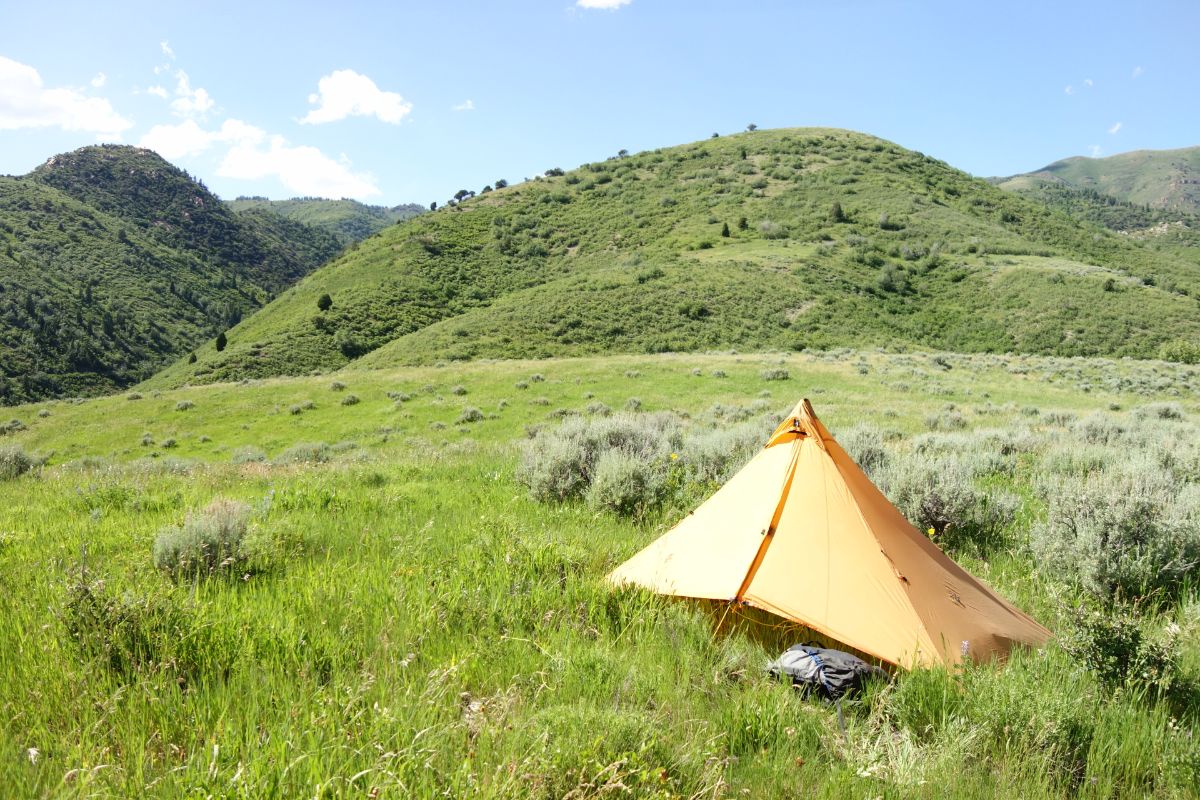
The Mountain Laurel Designs SoloMid XL on a fastpacking trip in Utah’s Wasatch Mountains. All photos: iRunFar/Ben Kilbourne
Mountain Laurel Designs SoloMid XL Pitching
The Mountain Laurel Designs SoloMid XL requires only one running pole for pitching, but it’s tall, so a provided strut is necessary to lengthen most poles to the right height. It is also possible to lash two trekking poles together using a bit of accessory cord or two Voile Straps. When using non-adjustable running poles, such as one of our favorites, the Black Diamond Distance Carbon Z Trekking/Running Poles, we like to use two Voile Straps for pitching, as we’ve found the method to be effective and sturdy.
The first step for setting up the SoloMid XL is to stake out the fly, ensuring that all four corners are at right angles, so the tarp lays across the ground as a rectangle. This is not difficult to do, but time should be spent on this step because it will make the rest of the process go much more smoothly and will prevent having to re-stake or adjust the shelter once pitched.
Once the tarp has been staked out fairly tightly, simply insert the handle end of a running pole into the apex of the tarp, place the other end of the pole on the ground so that the pole is vertical, and adjust its height until the entire structure is taut. This process could be a little different with fixed-length poles.
Because most fixed-length poles are in the 110- to 130-centimeter range and this tent needs a 140-centimeter pole for pitching, it’s a good idea to have this strut in your kit if you use fixed-length poles. You can also strap both of your fixed-length poles together with a couple of Voile Straps to get them to 140 centimeters. We recommend the Voile Strap method because it will provide more adjustability to adapt to variable terrain.
This whole process can take as little as 60 seconds once you get the hang of it. We appreciate this feature most when those summer monsoons roll in and you need to get out of the deluge quickly. Once the fly is pitched, you can dive inside — even if you’re drenched — and sort out your gear, piling wet things in a corner before setting up the SoloMid XL InnerNet.
The InnerNet is made to fill up the rear 70% of the tarp, so the front 30% by the doors functions as a vestibule. Simply clip the apex of the InnerNet to the apex of the tarp, and clip each corner to the mitten hooks sewn to the interior corners of the tarp to create your bug-proof sleeping area.
Mountain Laurel Designs SoloMid XL Versatility and Modularity
As you can see from the pitching instructions, the Mountain Laurel Designs SoloMid XL is designed to be set up tarp-first. We prefer this setup style to the reverse where you set up the mesh tent body first, which you’ll see on most dedicated pole tents.
This tarp-first pitch also means you don’t have to use the SoloMid XL InnerNet if bug pressure is not expected. We have used this tent this way on many occasions, especially in the canyon country of the Colorado Plateau where bugs are not usually an issue. With guylines and stakes, this tarp-only pitch weighs only about 24 ounces.
What’s more, the SoloMid XL is actually large enough to fit two people in this configuration. There’s not a lot of room to spare, and there’s a pole in between the two pads, but it’s a good option for those super-minimalist trips when a complete double-wall tent may be unnecessary.
With the InnerNet, the SoloMid XL becomes a fully enclosed, double-wall tent. In this configuration, the rear 70% of the tent is the sleeping area, and the front 30% is the vestibule. We have found double-wall tents to be the most weather-resistant types of shelters we’ve tested because they prevent sleeping bag loft degradation resulting from dripping condensation.
Mountain Laurel Designs SoloMid XL Stormworthiness
In both tarp-only and double-wall tent mode, the Mountain Laurel Designs SoloMid XL is extremely stormworthy. First of all, we can’t overstate the benefits of the tent’s rectangular base. This shape tensions the entire perimeter, creating a sturdy foundation. When the shelter is fully erected, this foundation ensures that the tent performs well in wind, despite the tall height of the pyramid.
Secondly, the four main seams that run from the peak to the corners have a slight catenary cut — meaning a convex curve — so the pyramid pitches very taut and doesn’t flop around or deform in wind.
Each corner guyline is adjustable with a LineLock — a little plastic piece that makes it easy to tension guylines — and each ground edge of the tarp also has a guyline with a LineLock, so it’s possible to use a total of eight perimeter stakes. Each of the four middle panels also has a sewn-in shock cord, so four more guylines can be added to prevent the walls from caving in.
We usually do not use these, as we’ve found them to be unnecessary except for preventing wall-collapse in snow. Finally, there is a loop of webbing at the peak of the pyramid. We like to attach a guyline here and stake it out in front of the door. In our experience, this stabilizes the entire structure tremendously.
And when you add the SoloMid XL InnerNet to the setup, it’s even better. The InnerNet is essentially a silnylon-bottomed pyramid-shaped mesh tent that clips into the rear half of the tarp. Its floor protects your pad from punctures and your sleeping bag from pooling water.
The mesh body blocks condensation drips from landing on your sleeping bag, keeping your bag dry and extending the loft and thus the life of your bag on longer trips. We use the SoloMid XL in double-wall mode for 75% of trips for this reason.
All of these features add up to a remarkably wind-resistant and stable pyramid tent inside of which we feel safe and secure. We’ve slept soundly in this shelter during tree-bending windstorms in the mountains and through all-night thunderstorms above treeline.
Mountain Laurel Designs SoloMid XL Weight
The Mountain Laurel Designs SoloMid XL we tested is constructed from a high-grade 20-denier silnylon and weighs about 16 ounces before guylines or seam-sealing. After seam-sealing and the addition of fairly long guylines, it comes in at 18.2 ounces. When you add eight stakes to that setup — the minimum we’d recommend for most trips — it will be right around 22 ounces, depending on your stake of choice.
With the SoloMid XL InnerNet, the tent will be 30.1 ounces, and the whole package with eight stakes is about 34 ounces. In our opinion, this is very light considering the storm protection this shelter provides and how much usable space there is inside.
Mountain Laurel Designs SoloMid XL Packed Size
The silnylon Mountain Laurel Designs SoloMid XL, which is the version we tested, packs down to about 4 x 14 inches. For context, the SoloMid XL’s packed size is about half the size of the Big Agnes Fly Creek HV UL2 Solution Dye tent, which we also tested. But silnylon is astonishingly compressible, and we found this shelter to smush down much smaller in our packs.
Mountain Laurel Designs SoloMid XL Pitched Size
The Mountain Laurel Designs SoloMid XL is 110 inches long, 54 inches wide, and 55 inches tall. It has an overall area of 44 square feet. The SoloMid XL InnerNet is 90 inches long, 32 inches wide, and 46 inches tall. This shelter’s fairly large size provides ample coverage so rain stays far from the sleeping area. The tarp can also be pitched all the way to the ground without losing much interior space.
Mountain Laurel Designs SoloMid XL Other Options
The Mountain Laurel Designs SoloMid XL we tested is constructed from 20-denier silnylon. We chose this material because we believe it offers an excellent balance of low cost, low weight, and good durability. The SoloMid XL can also be purchased in 0.75 ounce/square-yard Dyneema Composite Fabric (DCF).
This material is about an ounce lighter for the whole tent, absorbs water less readily, and has a higher tear strength. But, as per the Mountain Laurel Designs website, it does not last quite as long. It also is far more expensive — add $270 to the tarp alone if you want DCF!
Mountain Laurel Designs also makes larger pyramids for more occupants: the DuoMid, DuoMid XL, and SuperMid. One of our testers has used a DuoMid as his primary fastpacking shelter for over five years and likes it nearly as much as the SoloMid XL, especially for two-person trips.
Mountain Laurel Designs SoloMid XL Overall Impressions
Mountain Laurel Designs’ pyramid tents have been a staple of the ultralight backpacking world for nearly two decades. They’re widely regarded as adaptable, weather-resistant, and reliable. The Mountain Laurel Designs SoloMid XL is no exception, and in fact, we believe its size exhibits the absolute best application of this type of shelter design where the rear half of the pyramid is reserved for one person sleeping, and the front half is reserved for vestibule space.
One of our testers has used the SoloMid XL as his primary shelter for over five years and in all seasons. He has slept under just the tarp in canyon country where bug presence is negligible and more than 60 nights in the Uinta Mountains of northern Utah in double-wall tent mode where conditions ranged from wind to hail to rain to snow. He has even winter camped in SoloMid XL where it shed moderate snow loads effectively.
We like this tent so much that we named it one of the best tents in our best ultralight tents guide.
The SoloMid XL’s only detractors are the most extreme gram counters — it weighs 18.2 ounces for the tarp and 30.1 ounces for the entire tent — but we don’t think this is all that heavy considering the storm protection, versatility, and reliability this shelter provides.
There are other shelters that cater to specific kinds of trips where the lowest possible weight would be ideal, or where shelter use is unlikely, and we have many options for those types of trips and more listed in our best ultralight tents guide. If you need a lighter shelter or one with a dedicated pole set, for example, you should be able to find one in that guide.
But the Mountain Laurel Designs SoloMid XL stands apart from the other shelters we tested because it does everything well. We can count on it. It provides a sense of security that simply makes trips more enjoyable. When we know for certain that we will be safe, warm, dry, and comfortable at the end of the day, our attention is freed up to enjoy the landscapes through which we run.
Shop the Mountain Laurel Designs SoloMid XLCall for Comments
- Do you love pyramid shelters? Why or why not?
- Have you used the Mountain Laurel Designs SoloMid XL in winter?
- Have you slept two people in the SoloMid XL?
[Editor’s Note: If you’re affiliated (i.e., an employee, ambassador, etc.) with a brand, please share your relation in each of your comments on this article. Thanks!]
